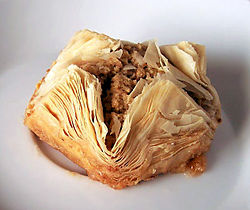| Revision as of 21:27, 2 November 2005 view source148.177.69.211 (talk) Added Lebanese pronunciation and category: Lebanese cuisine.← Previous edit | Revision as of 01:26, 4 November 2005 view source PinchasC (talk | contribs)8,782 edits →External links: Kosher Baklava recipeNext edit → | ||
| Line 26: | Line 26: | ||
| == External links == | == External links == | ||
| * | * | ||
| * chabad.org | |||
| * | * | ||
| * (photo: ]n baklava) | * (photo: ]n baklava) | ||
Revision as of 01:26, 4 November 2005

Baklava (or baklawa) is a popular sweet pastry in Assyrian, Lebanese (b'learwa), Greek (μπακλαβά), Albanian (bakllava), Bulgarian (баклава), Arab (بقلاوة baqlāwaḧ), Israeli (בַּקְלָוָה, בקלווה baqlava), Persian (باقلوا baqlavā), Armenian (փախլավա pʼaḫlava), Bosnian and Turkish cuisines with a high sugar content, making it extremely rich.
It is believed that the Assyrians in the 8th century BC were the first people in eastern mediterranean that baked a mixture of chopped nuts and honey with dough, creating thus the predecesor of baklava. According to this theory, greek seamen and merchants traveling east, soon discovered the delight and brought it back to Athens. The Greeks' major contribution to the development of this pastry was the creation of a technique that made it possible to roll dough as thin as a leaf, and thus wrap in multiple soft layers the chopped nuts. In fact, the name "Phyllo" was coined by Greeks, which means "leaf" in the Greek language. Trays of baklava as we know it today, were being baked in every kitchen of wealthy households in the region, for all kinds of special occasions from the 3rd Century B.C. onwards. During the Byzantine era the Armenians integrated for the first time the cinnamon and cloves into the texture of baklava. Later the Arabs introduced the rose-water and cardamom. The word Baklava itself, is derived from "baklavi", which is Arabic for nuts. A number of other nations have added their own spices creating their own version of baklava since then. In the Ottoman period that followed the collapse of Byzantium, Baklava became the favorite delight of the Sultans. Two principal ingredients, the walnut and honey, were believed to be aphrodisiacs, justifying its exreme price. To this day one can hear a common expression often used by the poor, or even by the middle class in Turkey, saying: "I am not rich enough to eat baklava and boerek every day". Monsieur Guillaume, a former pastry chef of Marie Antoinette, who was in exile at the Ottoman Turkish Palace. Although there was nothing much to add to baklava's already perfectioned taste and texture, there were some cosmetic modifications in shaping and in the presentation with a 'Frech touch'. Guillaume created the "dome" technique of cutting and folding of the baklava squares which was named "Baklava Francaise" (Frenk Baklavasi) and it's the most common shape of Baklava found today.

Baklava is a complex, layered dessert made with paper thin sheets of phyllo (filo) dough which have been buttered and layered in a rectangular baking dish, or layered and rolled into a log. Ground and finely chopped walnuts or pistachios are layered between the sheets of pastry, which are baked and soaked in a solution of sugar and either lemon juice or honey and spices with rosewater. In Greek and Turkish cuisine it is typically then cut into triangles, squares or diamonds and served. Also, in Turkish cuisine, the baklava sheet is rolled and cut into circular slices. As with any food, there are regional variations in the recipe with the most common ones being the syrup recipe and whether or not it contains honey.
If layering in a baking dish, layer and butter a dozen phyllo sheets, then top with a mixture of ground nuts and a little sugar (and cinnamon, for variation, if desired). Walnuts or pistachios are used most often sometimes with a combination of almonds, and pecans. After the nut mixture has been spread evenly across the phyllo, layer and butter the remaining dozen phyllo sheets. Before baking, cut baklava with a sharp knife into diamonds (traditional in Lebanese cuisine) or squares.
If rolling, butter 5 individual sheets of phyllo, then place nut mixture along 1 side of the phyllo and proceed to roll up like a tight log. Once rolled, cut the log on the diagonal into about 12 to 13 pieces. Do not cut all the way through until after the baklava is baked. For easier handling, the logs can be frozen for 10 to 15 minutes to firm them up.
Whether using the pan or rolled technique, the procedure is the same after the baklava is baked. Pour on the syrup (equal parts sugar and water boiled to a syrup consistency and then mixed with either a small amount of lemon juice or honey, cinnamon and cloves). Stays fresh and freezes well.
External links
- The History of Baklava
- Kosher Baklava recipe chabad.org
- Baklava online
- (photo: Bosnian baklava)
- (photo: Bosnian baklava)
- Dedeoglu Baklava